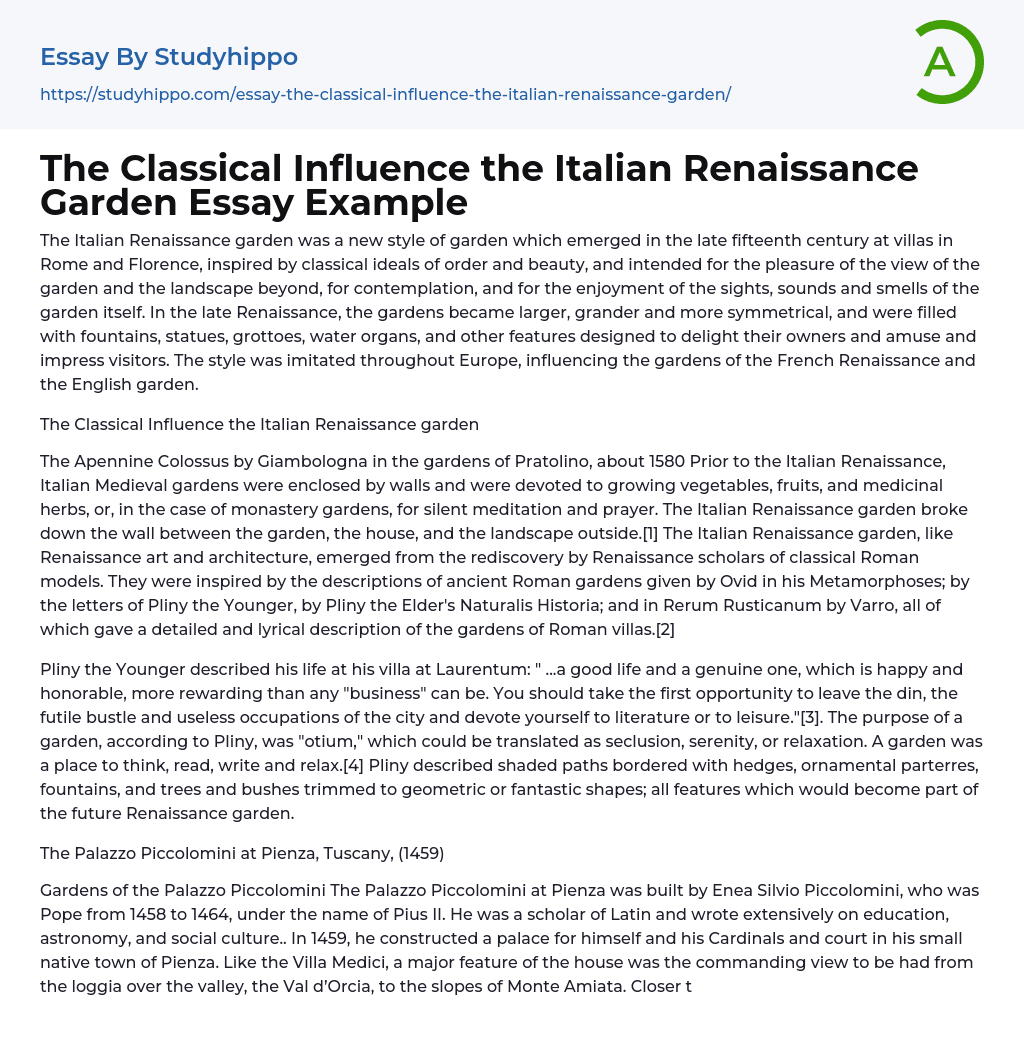

The Classical Influence the Italian Renaissance Garden Essay Example
The Italian Renaissance garden was a new style of garden which emerged in the late fifteenth century at villas in Rome and Florence, inspired by classical ideals of order and beauty, and intended for the pleasure of the view of the garden and the landscape beyond, for contemplation, and for the enjoyment of the sights, sounds and smells of the garden itself. In the late Renaissance, the gardens became larger, grander and more symmetrical, and were filled with fountains, statues, grottoes, water organs, and other features designed to delight their owners and amuse and impress visitors. The style was imitated throughout Europe, influencing the gardens of the French Renaissance and the English garden.
The Classical Influence the Italian Renaissance garden
The Apennine Colossus by Giambologna in the gardens of P
...ratolino, about 1580 Prior to the Italian Renaissance, Italian Medieval gardens were enclosed by walls and were devoted to growing vegetables, fruits, and medicinal herbs, or, in the case of monastery gardens, for silent meditation and prayer. The Italian Renaissance garden broke down the wall between the garden, the house, and the landscape outside.[1] The Italian Renaissance garden, like Renaissance art and architecture, emerged from the rediscovery by Renaissance scholars of classical Roman models. They were inspired by the descriptions of ancient Roman gardens given by Ovid in his Metamorphoses; by the letters of Pliny the Younger, by Pliny the Elder's Naturalis Historia; and in Rerum Rusticanum by Varro, all of which gave a detailed and lyrical description of the gardens of Roman villas.[2]
Pliny the Younger described his life at his villa at Laurentum: " ...a good life and
genuine one, which is happy and honorable, more rewarding than any "business" can be. You should take the first opportunity to leave the din, the futile bustle and useless occupations of the city and devote yourself to literature or to leisure."[3]. The purpose of a garden, according to Pliny, was "otium," which could be translated as seclusion, serenity, or relaxation. A garden was a place to think, read, write and relax.[4] Pliny described shaded paths bordered with hedges, ornamental parterres, fountains, and trees and bushes trimmed to geometric or fantastic shapes; all features which would become part of the future Renaissance garden.
The Palazzo Piccolomini at Pienza, Tuscany, (1459)
Gardens of the Palazzo Piccolomini The Palazzo Piccolomini at Pienza was built by Enea Silvio Piccolomini, who was Pope from 1458 to 1464, under the name of Pius II. He was a scholar of Latin and wrote extensively on education, astronomy, and social culture.. In 1459, he constructed a palace for himself and his Cardinals and court in his small native town of Pienza. Like the Villa Medici, a major feature of the house was the commanding view to be had from the loggia over the valley, the Val d’Orcia, to the slopes of Monte Amiata. Closer to the house, there were terraces with geometric flowerbeds surrounding fountains and ornamented with bushes trimmed into cones and spheres similar to the garden of Pliny described in Alberti's De Re Aedificatoria The garden was designed to open to the town, the palace, and the view.
- Arch essays
- Area essays
- Architecture essays
- Design essays
- Graffiti essays
- Graphic essays
- Interior design essays
- Painting essays
- Photography essays
- Sculpture essays
- Typography essays
- Cuban Missile Crisis essays
- Fidel Castro essays
- French Revolution essays
- Han Dynasty essays
- Hiroshima essays
- Imperialism essays
- Jack The Ripper essays
- Mao Zedong essays
- Middle Ages essays
- Mongols essays
- Nelson Mandela essays
- Ottoman Empire essays
- Reformation essays
- Reign of Terror essays
- Renaissance essays
- Roaring Twenties essays
- Romanticism essays
- Samurai essays
- Scientific Revolution essays
- Soviet Union essays



